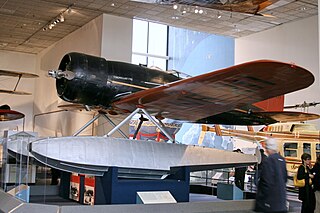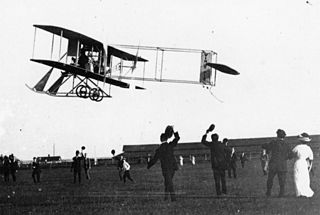 W
WThe Autogiro Company of America AC-35 was an early attempt to make a roadable aircraft in the United States during the 1930s. Although it was successfully tested, it did not enter production; a 1960s attempt to revive the aircraft in a non-roadable version also failed to achieve success.
 W
WThe Beck-Mahoney Sorceress was a racing staggerwing biplane originally designed by the father and son team of Lee and Seldon Mahoney with later improvements accomplished by pilot Don Beck.
 W
WThe Boeing 367-80, known simply as the Dash 80, is an American quadjet prototype aircraft built by Boeing to demonstrate the advantages of jet propulsion for commercial aviation. It served as basis for the design of the KC-135 tanker and the 707 airliner.
 W
WThe Enola Gay is a Boeing B-29 Superfortress bomber, named after Enola Gay Tibbets, the mother of the pilot, Colonel Paul Tibbets. On 6 August 1945, piloted by Tibbets and Robert A. Lewis during the final stages of World War II, it became the first aircraft to drop an atomic bomb. The bomb, code-named "Little Boy", was targeted at the city of Hiroshima, Japan, and caused the near-complete destruction of the city. Enola Gay participated in the second atomic attack as the weather reconnaissance aircraft for the primary target of Kokura. Clouds and drifting smoke resulted in a secondary target, Nagasaki, being bombed instead.
 W
WFlak-Bait is a Martin B-26 Marauder aircraft that holds the record within the United States Army Air Forces for the number of bombing missions survived during World War II. Manufactured in Baltimore, Maryland as a B-26B-25-MA, by Martin, it was completed in April 1943 and christened Flak-Bait by its first assigned pilot, James J. Farrell, who adapted the nickname of a family dog, "Flea Bait". Flak-Bait was assigned to the 449th Bombardment Squadron, 322d Bombardment Group stationed in eastern England.
 W
WThe Great Artiste was a U.S. Army Air Forces Silverplate B-29 bomber, assigned to the 393d Bomb Squadron, 509th Composite Group. The aircraft was named for its bombardier, Captain Kermit Beahan, in reference to his bombing talents. It flew 12 training and practice missions in which it bombed Japanese-held Pacific islands and dropped pumpkin bombs on targets in Japan. It was the only aircraft to participate in both the bombings of Hiroshima and Nagasaki, albeit as an observation aircraft on each mission.
 W
WThe Langley Aerodrome was a pioneering but unsuccessful manned, powered flying machine designed at the close of the 19th century by Smithsonian Institution Secretary Samuel Langley. The U.S. Army paid $50,000 for the project in 1898 after Langley's successful flights with small-scale unmanned models two years earlier.
 W
WThe Gossamer Albatross is a human-powered aircraft built by American aeronautical engineer Dr. Paul B. MacCready's company AeroVironment. On June 12, 1979, it completed a successful crossing of the English Channel to win the second £100,000 (£509644 today) Kremer prize.
 W
WThe MacCready Gossamer Condor was the first human-powered aircraft capable of controlled and sustained flight; as such, it won the Kremer prize in 1977. Its design was led by Paul MacCready of AeroVironment, Inc.
 W
WThe Northrop N-1M, also known by the nickname "Jeep", was an American experimental aircraft used in the development of the flying wing concept by Northrop Aircraft during the 1940s.
 W
WThe Piasecki PV-2 was a helicopter designed by Frank Piasecki. The PV-2 is best known for being the second successful helicopter flown in the United States. The PV-2 first flew on April 11, 1943. Developed as a technology demonstrator, the PV-2 brought several new features such as the first dynamically balanced rotor blades, a rigid tail rotor with a tension-torsion pitch change system, and a full cyclic and collective rotor pitch control.
 W
WPolar Star is the airplane used by polar explorer Lincoln Ellsworth, an early adaptor of airplanes for polar exploration and worked closely with Robert Peary.
 W
WThe Rutan Model 76 Voyager was the first aircraft to fly around the world without stopping or refueling. It was piloted by Dick Rutan and Jeana Yeager. The flight took off from Edwards Air Force Base's 15,000 foot runway in the Mojave Desert on December 14, 1986, and ended 9 days, 3 minutes and 44 seconds later on December 23, setting a flight endurance record. The aircraft flew westerly 26,366 statute miles at an average altitude of 11,000 feet (3,350 m).
 W
WSpaceShipOne is an experimental air-launched rocket-powered aircraft with sub-orbital spaceflight capability at speeds of up to 900 m/s (3,000 ft/s), using a hybrid rocket motor. The design features a unique "feathering" atmospheric reentry system where the rear half of the wing and the twin tail booms folds 70 degrees upward along a hinge running the length of the wing; increasing drag while remaining stable. SpaceShipOne completed the first crewed private spaceflight in 2004. That same year, it won the US$10 million Ansari X Prize and was immediately retired from active service. Its mother ship was named "White Knight". Both craft were developed and flown by Mojave Aerospace Ventures, which was a joint venture between Paul Allen and Scaled Composites, Burt Rutan's aviation company. Allen provided the funding of approximately US$25 million.
 W
WThe Spirit of St. Louis is the custom-built, single-engine, single-seat, high-wing monoplane that was flown by Charles Lindbergh on May 20–21, 1927, on the first solo nonstop transatlantic flight from Long Island, New York, to Paris, France, for which Lindbergh won the $25,000 Orteig Prize.
 W
WThe Spirit of Texas, a Bell 206L-1 LongRanger II, is the first helicopter to complete a round-the world flight.
 W
WTingmissartoq was the name given to a Lockheed Model 8 Sirius flown by Charles and Anne Morrow Lindbergh in the 1930s. Tingmissartoq means "one who flies like a big bird"; the plane was thus christened by an Inuit boy in Godthaab (Nuuk), Greenland, who painted the word on its side.
 W
WThe Vin Fiz Flyer was an early Wright Brothers Model EX pusher biplane that in 1911 became the first aircraft to fly coast-to-coast across the U.S., a journey that took almost three months.
 W
WThe Scaled Composites Model 311 Virgin Atlantic GlobalFlyer is an aircraft designed by Burt Rutan in which Steve Fossett first flew a solo nonstop airplane flight around the world in slightly more than 67 hours. The flight speed of 551 km/h set the world record for the fastest nonstop non-refueled circumnavigation, beating the mark set by the previous Rutan-designed Voyager aircraft at 9 days 3 minutes and a top speed of 196 km/h.
 W
WChief Oshkosh a.k.a. Buster is a homebuilt racing plane designed to compete in the 1931 American Cirrus Races.
 W
WThe Wright Flyer was the first successful heavier-than-air powered aircraft. Designed and built by the Wright brothers, they flew it four times on December 17, 1903, near Kill Devil Hills, about four miles south of Kitty Hawk, North Carolina. Today, the airplane is exhibited in the National Air and Space Museum in Washington D.C. The U.S. Smithsonian Institution describes the aircraft as "the first powered, heavier-than-air machine to achieve controlled, sustained flight with a pilot aboard." The flight of the Wright Flyer marks the beginning of the "pioneer era" of aviation.
 W
WThe Wright brothers designed, built and flew a series of three manned gliders in 1900–1902 as they worked towards achieving powered flight. They also made preliminary tests with a kite in 1899. In 1911 Orville conducted tests with a much more sophisticated glider. Neither the kite nor any of the gliders were preserved, but replicas of all have been built.